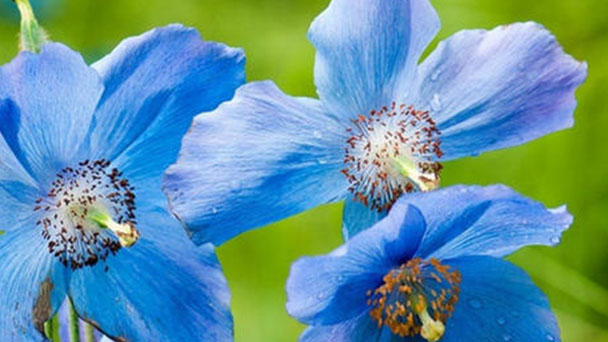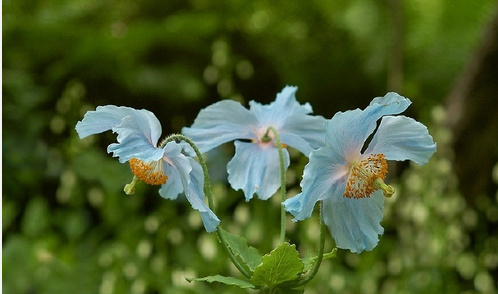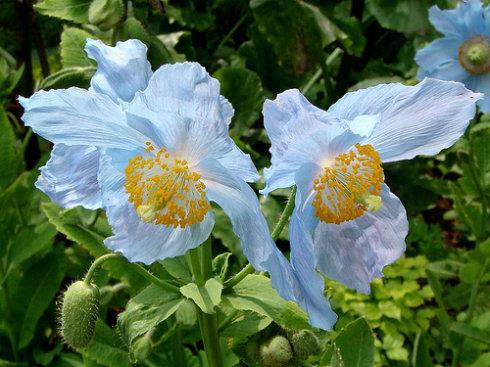Blue poppy (Meconopsis betonicifolia) profile
Written by Maggie
Apr 19 2021

Blue poppy is an annual or perennial herb, with yellow juice. One species is native to Western Europe, the other 48 species are equally distributed in the China-Himalayas region, but the most original species is in central China.
There are 38 species in China, of which 17 species are concentrated in Yunnan. Most of them are concentrated in the snow-mountain meadows, alpine shrubs and rock beaches with altitudes of 3000--5000 meters in northwest Yunnan, and a few species are concentrated in the subalpine areas in central and northeast Yunnan. Qilian Mountains in the northwest also have distribution.
Blue poppy picture

Blue poppy info
| Botanical Name | Meconopsis betonicifolia or Meconopsis baileyi |
| Common Names | Blue Poppy. Himalayan Blue Poppy |
| Plant Type | Perennial, Herbaceous |
| Sun | Part Shade |
| Hardiness Zones | 5-7, USA |
| Flower color | Blue |
| Native Area | Himalayas |
| Mature size | Up to 4 ft. tall |
Morphological characteristics of blue poppy
Rhizome
Blue Poppy is an annual or perennial herb, 15-60 cm tall, with rusty or yellowish bristles all over. Taproots are conspicuous, hypertrophic and prolonged or radish like thickening. Stem is branched or unbranched, or basal scapes, spiny, hirsute, pilose, or glabrous.
Leaf
The leaves of Blue Poppy are all basal rosettes or also on the stem, and the rosettes are usually persistent in winter. Leaf blade is entire, serrate, pinnately lobed to pinnately lobed, glabrous to spiny; Basal and lower cauline leaves are long stalk, upper cauline leaves short stalk or sessile, sometimes extrapulse.
Flowers
Peanuts of Blue Poppy are on scapes or on inflorescences without or with bracts, solitary or arranged racemally or paniculate. The flowers are large and beautiful, blue, purple, red or yellow, thin white; Sepals 2, very sparse 3-4 on terminal flowers, caducous; Petals are usually 4, sometimes 5-10; Stamens are numerous, filaments mostly filiform, sparse lower part or whole for strip; Ovary is subglobose, ovate, obovate to narrowly cylindrical, 1-loculed, 3-polycarpellate, ovules numerous, styles conspicuous, usually short, sometimes nearly vanishes, equally thick from upper to lower or base expanded into disk and covered on ovary, stigma separated or united, head or clavate, often radiate downward, opposite to placenta.
Fruit
Capsule of Blue Poppy is subglobose, ovate, obovate, elliptic to narrowly cylindrical, bristling, hirsute or glabrous, 3-12 lobes lobed or dehiscent from apex to base to 1/3 or more of full length, sparsely lobed to base. Seeds are many, ovate, reniform, falcate oblong or long elliptic, smooth or with longitudinal indentation, without caruncle.
Ecological habits of blue poppy
Blue Poppy is a wild alpine flower that grows on the frontiers of rock beaches and glaciers at altitudes of 3,000 to 4,000 meters. Known as the "mountain peony", the European respected as the "world famous flower".
Blue Poppy is mainly distributed in the snow-mountain meadows, alpine shrubs, streamstone beaches, and a few species in the subalpine areas of central and northeastern Yunnan.
How to grow and care for blue poppy
Light
In their native habitat, Himalayan blue poppies would develop on damp woodland flooring the place they would obtain dappled light. These vegetation can not live on if they are uncovered to too much severe sunlight. They decide upon a partial color function with vibrant however oblique light.
If you stay in an area that experiences very slight summer time temperatures, they may additionally nevertheless manipulate in a greater sunny position, but, ideally, this would solely expose them to direct morning sun.
Soil
Blue poppies have very precise soil requirements. To thrive, they want a moist however well-drained kind that is wealthy in natural matter. Loamy soils work best, and fanatics regularly enrich them with leaf Remember to reduce the danger of stagnation and to preserve moisture.
They are additionally noticeably touchy to pH levels. A soil check is encouraged earlier than planting as they opt for an impartial to barely acidic type. Too much alkalinity results in the blooms turning crimson as a substitute than blue, and it can influence growth.
Water
Blue poppies want to be constantly moist at some point of their boom duration in the late spring and summer. In the winter, their desire is to be stored dry, so no supplemental watering is commonly required.
Temperature and humidity
Blue poppies may not be splendid for developing in the southern states that are warm and humid. Temperate areas that do not have overly warm summers are exceptional for these plants.
Fertilizer
If your soil hasn't been enriched sufficiently with manure, compost or leaf mold, you ought to observe a susceptible dose of slow-release granular fertilizer at some stage in the spring and summer time boom period.
Pruning
Experts agree that throughout the first 12 months of growth, any buds performing on stems ought to be eliminated earlier than they flower. That way, your blue poppies will be in a position to focus on setting up sturdy roots and growing their foliage. This will motivate this notably short-lived plant to continue to exist longer.
Cutting them down to the floor in late fall is additionally a frequent practice.
Propagating blue poppy
Clumps that are turning into overcrowded need to additionally be divided as this can assist to extend the existence of blue poppies. Do endure in mind, however, if you layout to divide your plant to create a new clump some other place in your garden, given the durability of this species, they may additionally no longer continue to exist all that a good deal longer. For this reason, propagation is regularly great performed from seeds.
How to grow blue poppies from seed
Growing blue poppies from seeds is not viewed as an handy task. The germinating seeds want respectable light, can be susceptible to damping off (a fungal sickness that influences the growing roots), and they do not reply properly to being transplanted.
Sowing clean seeds is recommended. They ought to be sown thinly on the floor of their nutrient-rich soil or beginning mix. This have to be saved evenly moist, however make positive it would not get waterlogged. To forestall transplant shock, they might also do higher being sown in peat pots.
Unlike set up plants, blue poppy seeds want a first rate quantity of mild for profitable germination, and perfect temperatures are around fifty five to 60°F. Intense, extended sunlight, however, ought to nonetheless be avoided.
Pests & disease of blue poppy
You can also want to defend your blue poppies from slugs and snails and they can be susceptible to downy mildew on their foliage.

Variety classification of blue poppy
The Blue Poppy family is thriving, with a total of 49 species. Except for one species from Western Europe, the rest are distributed in the Himalayas and the Hengduan Mountains of China. Lijiang has eight. Most of them are concentrated in the snow-covered mountain meadows, alpine shrubs and rock banks at an altitude of 3000 ~ 5000 meters in northwest Yunnan. A few species are found in the subalpine areas in central Yunnan and northeast Yunnan. Hengduan Mountain is the center of the Blue Poppy family, where there are 39 species, of which the light Blue Lijiang Blue Poppy and the bright yellow Gongshan Blue Poppy are the most famous. Qilian Mountains in the northwest also have distribution, common yellow, stunning shape color.
Blue Poppy M. Aculeata
Blue poppyM. Argemonantha
Blue Poppy M. Barbiseta
Blue Poppy M. Betonicifolia
Blue Poppym. Chelidonifolia
Elegant Blue Poppy M. Concinna
Blue Poppy M. Delavayi
Xizang Blue Poppym. Florindae
Blue Poppy M. Forrestii in Lijiang
Blue Poppy M. Georgei
Blue Poppy M. Gracilipes
Blue Poppy M. Grandis
Blue Poppy M. Henrici
Spiny Blue Poppy M. Horridula
Blue Poppy M. Impedita in western Yunnan
The entire leaf is Blue poppy M. integrifolia
Long leaf Blue Poppym. Lancifolia
Blue Poppy M. Lyrata
Blue Poppy M. Napaulensis from Nepal
Blue Poppym. Oliverana
Blue Poppy M. Paniculata
Primulina Blue Poppy M. Primulina
Pseudohorridula Blue poppy M. pseudohorridula
Pseudovenusta Blue poppy M. pseudovenusta
Red Flower Blue Poppy M. Punicea
M. quintuplinervia of the five-vein group
Racemosa Blue Poppy M. Racemosa
Single leaf Blue Poppy M. Simplicifolia
Gonshan Blue Poppy M. Smithiana
Beautiful Blue Poppy M. Speciosa
Tall Blue Poppy M. Superba
Blue Poppy M. Venusta
Blue Poppy M. Violacea
Umon Blue Poppym. Wumungensis
Blue Poppy M. Zangnanensis, et al
Blue poppy's distribution region
There are 49 species of Blue Poppy in the world, which are mainly produced in central and southern Asia, and the most abundant in China. There are 40 species distributed in Tibet, Yunnan, Sichuan, Qinghai, Gansu, Shaanxi and other provinces, among which 17 species are in Yunnan.
Blue poppy uses
Medical use
Blue poppy is not only beautiful in color and has high ornamental value, but also can be used as medicine to cure diseases. For example, the whole Blue Poppy (also known as "Yellow Lotus" in Lijiang) and the whole Nepalese Blue Poppy (also known as "Shanwo Bamboo" in Luquan) herbs have the effect of clearing away heat and detoxification, clearing away heat and relieving cough; Leaves were collected before anthesis to treat acid reflux in stomach. Flower antipyretic emetic, anti-inflammatory, but also treats broken bones. The total Blue poppy, also known as "red hair ginseng" and "snow ginseng", is used as medicine to treat Qi deficiency, edema, asthma and other diseases, and has the effect of tonifying the middle.
Gaeden use
Blue Poppy should be decorated with a flower garden and a sparse forest background. Blue Poppy is large in flower shape and bright in color, so it has a high appreciation.
Latest Updated
- Benefits of Bugleweed - 7 Science-backed Health Benefits
- Bugleweed Dangers & Side Effects - Is It Poisonous?
- How to Plant Evergreen Trees - What You Should Know
- When to Plant Evergreens - Grow Guide for Evergreen Trees
- 12 Wonderful Evergreen Shrubs for Your Garden
- 12 Popular Evergreen Plants with Pictures for Beginners
- When And How To Prune A Lilac Bush Like a Pro
- How to Grow & Care for Lilac Vine (Hardenbergia Violacea)
- Japanese Lilac Tree (Syringa Reticulata) Care & Propagation Guide
- Shumard Oak Pros and Cons - What to Know
Popular Articles
- Winter maintenance of Antirrhinum Majus
- How to Grow Terminalia Mantaly Tree
- How to Grow and Care for Crossostephium Chinense
- How to grow Antirrhinum Majus in spring
- Peristeria Elata (Dove Orchid) Profile: Info & Care Guide
- Underwatered Snake Plant (Sansevieria Trifasciata) - Signs And How To Fix
- How to Care for Brazilian Jasmine Plant (Mandevilla Sanderi)
- How to Grow & Care for Graptopetalum Purple Delight in Summer
- Rosa Chinensis (China Rose): Plant Growing & Care Tips
- How to Care for Baby Sun Rose (Aptenia Cordifolia)